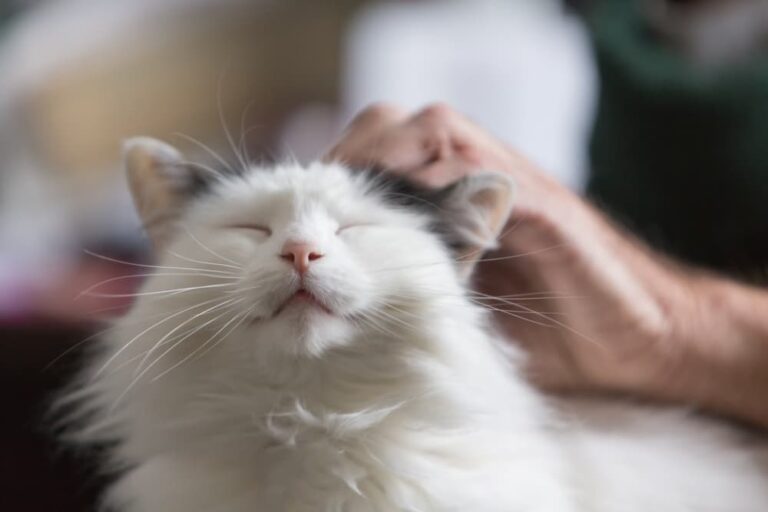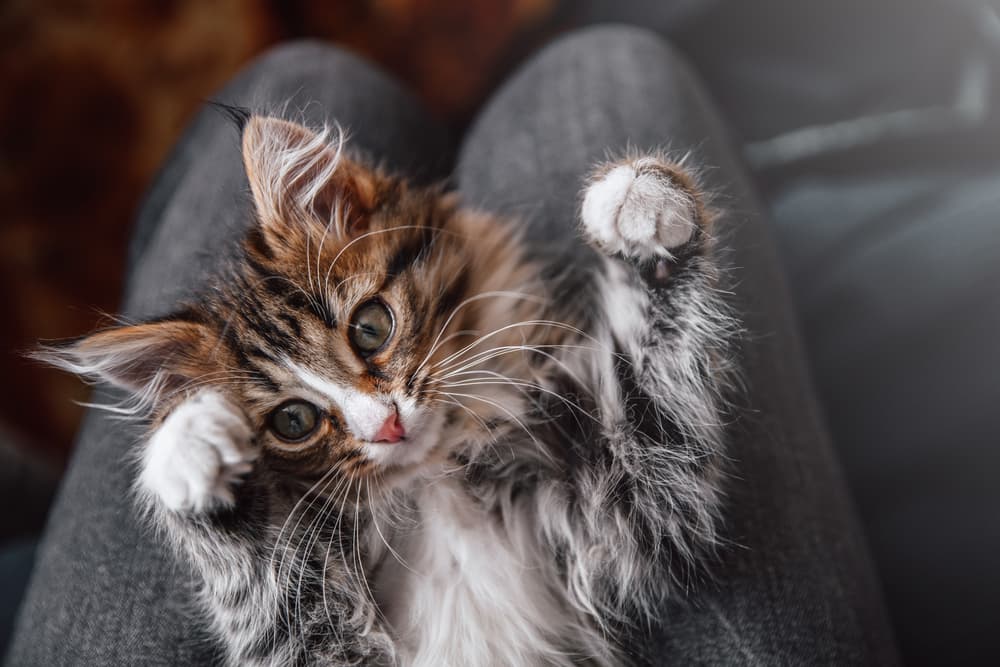How Exactly Do Cats Purr?

The gentle rumble of a cat purring is a calming experience and one of the most precious gifts from a feline family member. Purring is a common cat sound aside from meowing, hissing, and growling.
Contrary to popular belief, cats don’t just purr when they are content. A domesticated cat may purr when tickled or pet, but felines also purr to communicate with those close to them, express needs like hunger, and when they are nervous or not feeling well.
Mama cats use purring vibrations to guide kittens to their warmth and comfort, while kittens purr to communicate and bond with their mothers and littermates. Purring—instead of making other vocalizations—makes it more difficult for predators to locate recent moms and kittens in the wild.
For pet parents, research shows that the low frequency of purrs brings on relaxation, helps relieve anxiety, and decreases high blood pressure. There’s even been a purr-like vibration device patented for use in therapeutic healing.
If you’ve ever wondered what makes a cat purr and how a cat purrs, here’s a guide to everything you need to know about this specific vocal feature. This includes information on the meaning of different kinds of purring and when to be concerned.
How Do Cats Purr?

Domestic cats and smaller wild cats such as pumas, cheetahs, ocelots, and bobcats have the mechanics to purr. Interestingly, very big cats like lions, jaguars, tigers, and leopards are not able to produce this feline vocalization.
Dr. Jamie Richardson, medical chief of staff of Small Door Veterinary in New York City, explains that a cat’s purring involves the brain, larynx (the throat), and diaphragm (the muscle responsible for breathing, separating the chest and abdominal cavity). “This complex process starts in the brain, which signals nerves to the larynx and diaphragm to oscillate, causing tension on the glottis, which contains the vocal cords,” she says. “When the cat then breathes in or out, a purr results due to the tension/relaxation on the glottis.”
A cat’s laryngeal muscles can flutter at a frequency of 25 to 150 Hz (vibrations per second), producing a low, continuous buzzing that is both audible and palpable. These low frequency vibrations are known to heal bones and relieve pain in muscles, tendons, ligaments and joints. If you find your cat purring away as she rests or after a fall from a fence, she’s helping herself heal.
Purring is a complex process that benefits both the cat and those around her. As a palpable and auditory communication signal, it is important in cat’s social lives.
When Do Cats Learn to Purr?

Cats learn to purr from a young age and the mechanism is vital to their survival. “A kitten’s natural instinct to purr starts from as early as two days old,” says Richardson. “This helps them communicate with their mother and between littermates.”
A mother cat communicates with her newborn babies through the purring vibrations to let them know that she’s there, as the babies are born without sight or hearing. Purring, in lieu of meowing or other cries, helps vulnerable new moms and newborns stay safe from predators who are less likely to detect the vibrations.
Why Do Cats Purr?

Purring expends energy, and both domestic and wild cats would not have evolved to purr if it didn’t serve a purpose. Up until the 2000s, it was widely believed that cats used purring as a communication tool. Studies since have confirmed that felines purr as a way to express contentment and anxiety, self-heal injuries, and to get the attention of mothers and littermates.
There are a host of reasons behind different types of purring. Richardson says, “Happy/content purrs have been described as ‘melodious,’ whereas sick/stressed purrs are more monotonous.”
When a cat wakes you up in the morning with purring intermingled with whining (similar in frequency to that of a human infant’s cries), she’s hungry and alerting you to feed her. Pet parents are conditioned to feed cats before even having their own breakfast, showing how this type of purring can produce immediate results.
What Does it Mean When a Cat Purrs?

The behavior exhibited by a kitten at an early age to get the attention of her mom oftentimes continues into adulthood. The cat expresses hunger and the need to be fed by way of purring with a high frequency cry.
A study spearheaded by Karen McComb, PhD at the University of Sussex in Brighton, U.K., explored the relationship between insistent purring and the animal’s needs. The study of 10 felines revealed that cats often embed a cry within their purr (known as a solicitation purr) that is “more urgent and less pleasant” (like a baby’s cry), which is less likely to be ignored by humans.
In fearful or stressful situations, when arriving in a new home or placed in a carrier to visit the veterinarian, cats purr as a comfort mechanism.
A study by Elizabeth von Muggenthaler, a bioacoustician from the Fauna Communications Research Institute in North Carolina, published in The Journal of the Acoustical Society of America, concluded that not only do cats purr when expressing contentment, but also “when they are severely injured or frightened.” According to the study, the specific frequency at which a cat purrs (25 Hz and 50 Hz) is able to promote the growth of bones and heal fractures. Thanks in part to the healing properties of this specific vocalization, cats seem to rebound more quickly from injuries than other animals.
Understanding Your Cat’s Purring

To better understand why your cat is purring, look to her body language and behavior. Richardson suggests that if the cat is kneading with her paws, butting her head, or rubbing up against you, she is happy and content. If a cat is crouched low to the ground and looks at you with dilated pupils, she is likely afraid or anxious.
When a cat looks lethargic or shows symptoms of malaise, she is likely not feeling well and needs medical attention.
Cat Vocalizations: When to Be Concerned

Cat noises, even purring, can signal a health issue. Richardson suggests that when you notice your cat being sluggish or exhibiting increased lethargy or tiredness while purring, it is time to go to the veterinarian. A change in the loudness, tone, or clarity of a purr can indicate a medical problem.
“Loud vocalizations can also occur when a cat is in pain. The most classic example of this is when a cat is having urinary issues,” she explains. “Often, they will be in and out of the litter box trying to urinate and vocalizing, which should signal a prompt visit to the veterinarian.”
The best thing pet parents can do is pay attention to body language associated with any sounds cats make. “If vocalizations are concurrent with any clinical symptoms of illness, such as vomiting, breathing problems, or difficulty urinating/defecating—a trip to the veterinarian is warranted,” Richardson says.









